What It is | Bhastrika Pranayama Benefits | How to Do | Types | Precautions & Contraindications
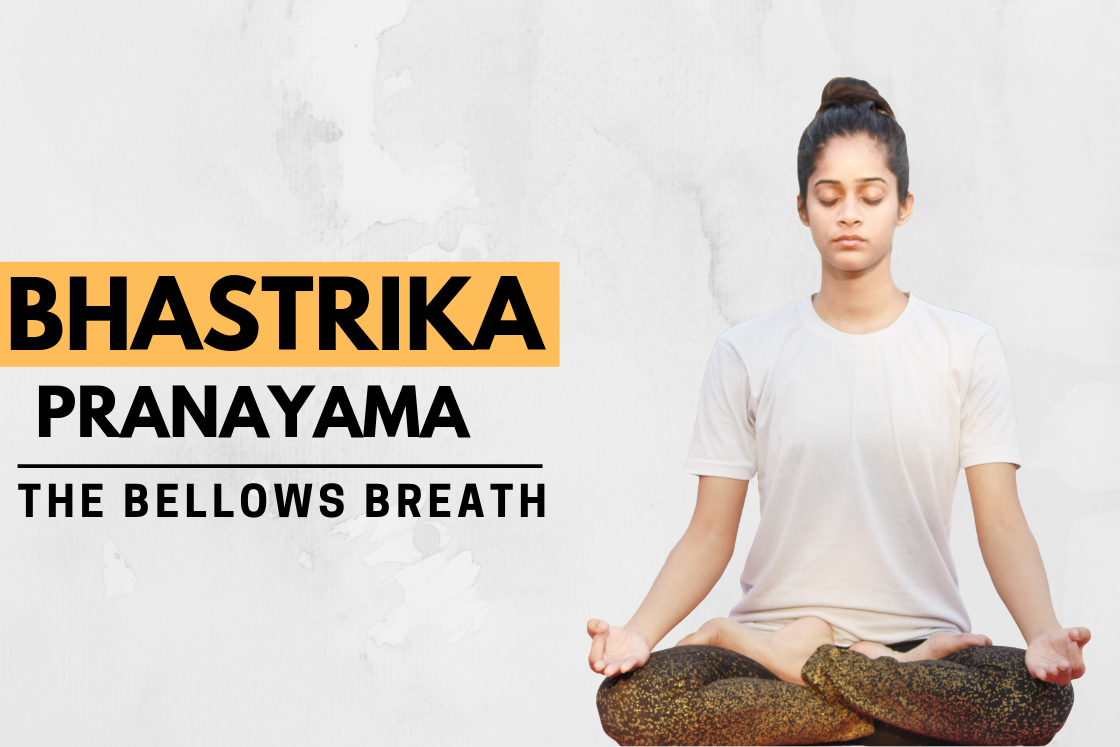
In bhastrika pranayama, we produce strong gusts of air to activate the fire energy in the navel chakra – and in turn, the whole body.
Even though Bhastrika Pranayama is a fast breathing exercise but its after-effects are very calming and relaxing. It’s worth practicing especially when you feel down, stressed, or anxious.
What is Bhastrika Pranayama
Bhastrika is one of the eight traditional pranayamas described in Hatha Yoga Pradipika. The name of this pranayama is taken from Sanskrit word bhastra which means bellows.
The way bellows squeezed together with two handles to produce fire, in bhastrika pranayama (bellows breathing), abdominal and diaphragm muscle rapidly draw in and out to generate heat in the body.
The best thing about Bhastrika pranayama is that it lets one evolve the habit of equal breathing. Unlike Kapalbhati, It’s a must in this pranayama to have equal emphasis on inhale and exhale. Breathing equally creates more space in the lungs and thus with every breath more air is exchanged.
When in less time, with fast breathing more air is exchanged, it produces heat in the body and stimulates the digestive fire.
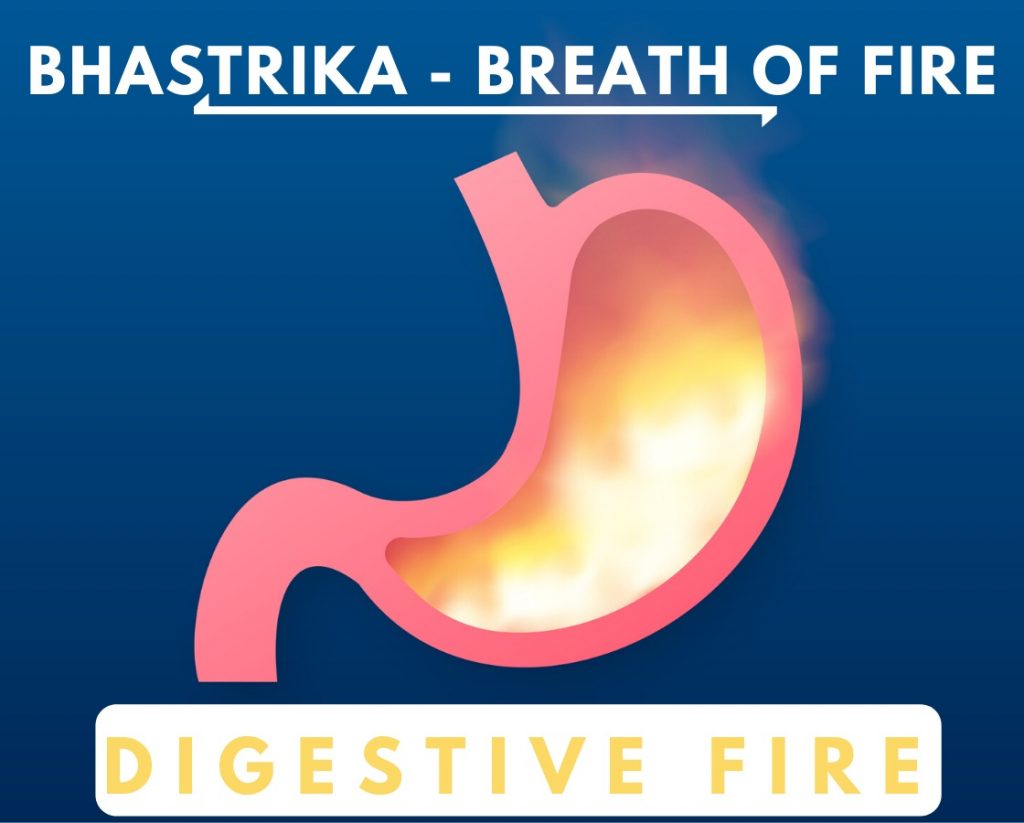
Yogis usually do this pranayama before going into the heavy postures to heat up the body. This is why some yogis call bhastrika pranayama breath of fire (BOF). In Kundalini yoga, it’s a preparatory breathing exercise.
If you’re doing the fast type of bhastrika (3-4 breathe/second), you will feel this heat in the first round only.
Bhastrika Pranayama Benefits
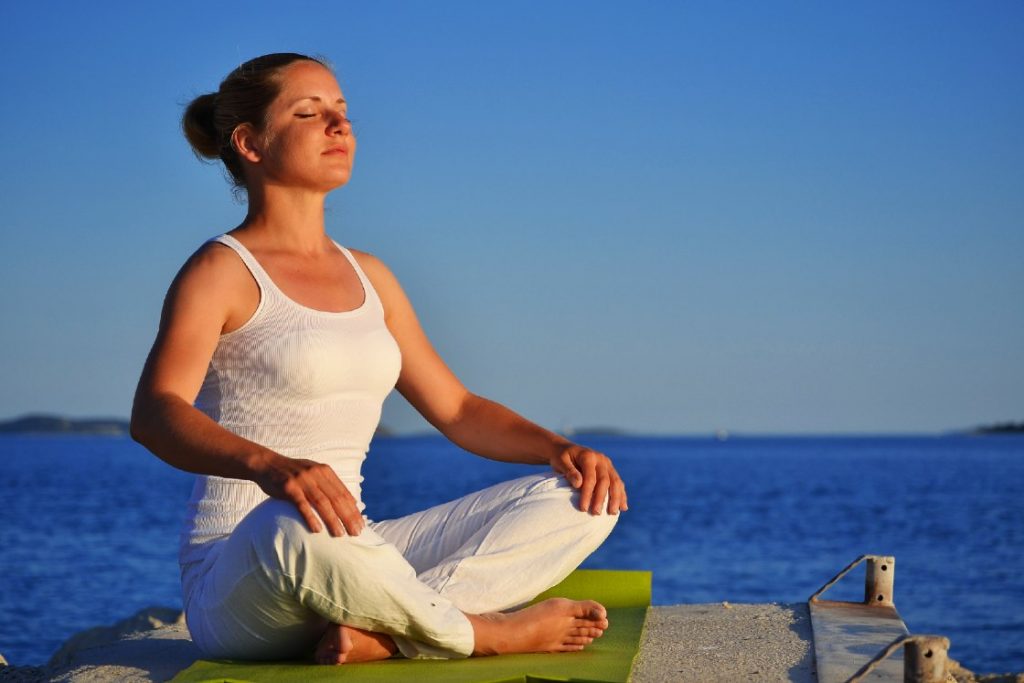
- In case of diabetes, it helps in the secretion of insulin hormone.
- Cures diseases related to imbalance Kapha dosha (cough, congestion).
- It strengthens respiratory muscles that increase lung capacity, especially helpful for athletes, swimmers, and dancers [efn_note] Changes in Lung Function Measures Following Bhastrika Pranayama (Bellows Breath) and Running in Healthy Individuals. https://www.ncbi.nlm.nih.gov/pmc/articles/PMC6746052/ [/efn_note].
- Very helpful practice in case of oxygen deficiency (hypoxia).
- Activate solar plexus chakra, boosts metabolism – improves digestion.
- very effective pranayama for weight loss.
- In beginners, practicing slow pace bhastrika lowers the blood pressure [efn_note] Immediate Effect of Slow Pace Bhastrika Pranayama on Blood Pressure and Heart Rate. https://pubmed.ncbi.nlm.nih.gov/19249921/ [/efn_note]
- Bhastrika activates the parasympathetic nervous system to reduce stress response.
- Stabilizes the Prana (vital life-force) and calms the mind
- Clears any blockages present in nadis and purifies it.
- Exerts pressure at the pelvic floor to awaken kundalini.
- Reduces mind’s chatter, hence builds a better platform for meditation practice.
How to Do Bhastrika Pranayama
- Come over your mat, sit in Sukhasana, close your eyes, and relax.
- Take a long deep breath. As you breathe in expand the chest and abdomen.
- Begin bhastrika breathing by inhaling and exhaling fast at 1 breath per second speed. Inhale and exhale rapidly with a hissing sound from nostrils as you gasping after a sprint.
- At the end of 10th breath, inhale deep in a relaxing manner followed by a slow long exhalation.
- Breathe normally for 10 seconds and then begin the next round with fast breathing for 20 breaths. In the third round, increase your breath counts to 30 breaths.
- Complete the practice after 3rd round by a few rounds of deep breathing and then slowly come out of the pose.
The most suitable time for bhastrika breathing is the morning period when air is cool comparably. If it’s not possible to do in the morning, evening time is also a good choice. In a pranayama session, it should be practiced after Kapalbhati and Ujjayi breath.
NOTES
- Check if you’re moving your body too much! Only moving parts should be your abdomen and chest.
- Check after the first round if the spine is aligned or not! Usually in the fast breathing people lost alignment.
- In the beginning, little pain can be experienced in the collarbones and chest region.
This is the traditional method of doing Bhastrika mentioned in Hatha Yoga Pradipika.
There is another way of doing bhastrika which involves the movement of arms and shoulder along with abdominal breathing.
Bhastrika Pranayama With Arms
- Sit straight and place both your hands next to your shoulders.
- Close your both hands palm to make a fist.
- Begin bhastrika, inhale, raise your arms up and open the fist. As you breathe in, expand the chest and abdomen as well.
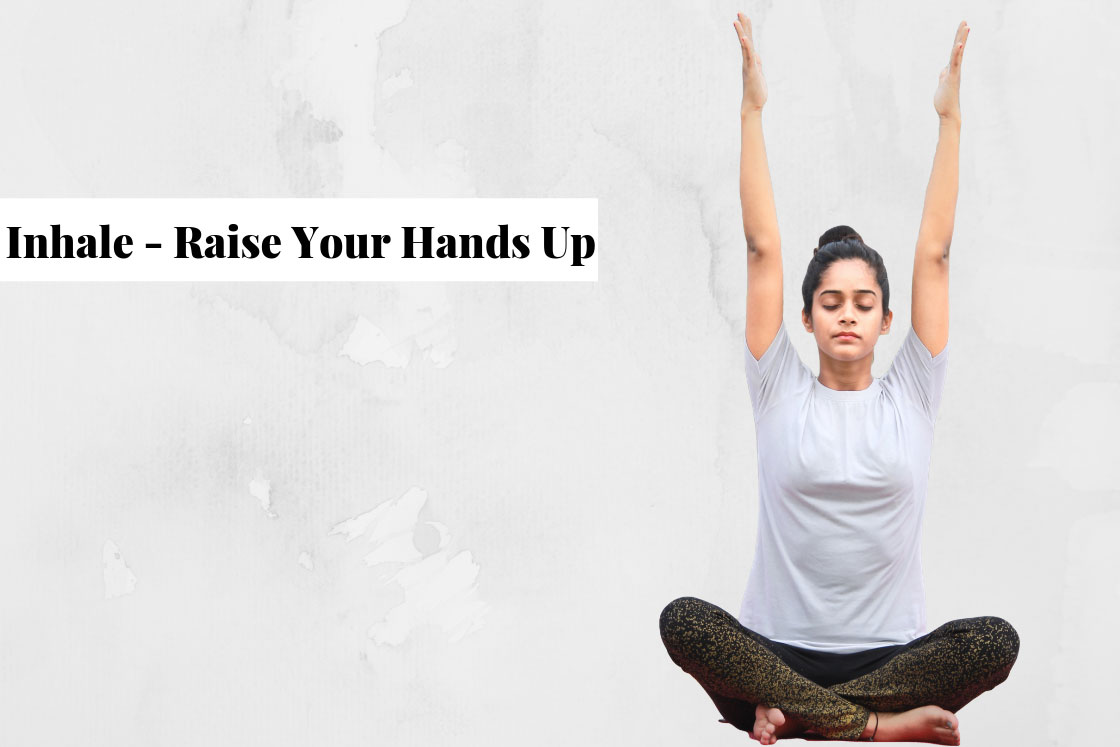
- Exhale, bring back your amrs down to shoulder level and close your fist. Contract the abdomen in while closing the fist.
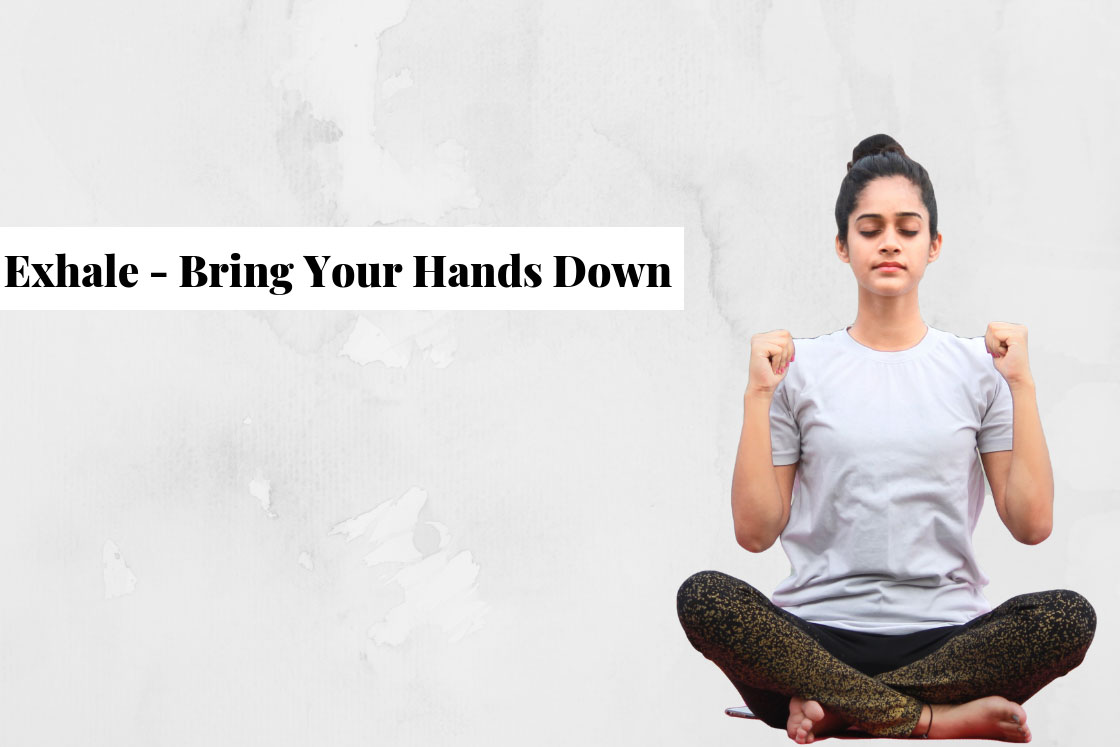
Inhale and exhale rapidly in this process. Do it for 10 breaths (1 round) and then relax before beginning another round.
Types of Bhastrika Pranayama
Based on the frequency & rate of breathing, Bhastrika can be categorized into 3 types.
1. Fast Pace Bhastrika – teevre gati
In fast bhastrika pranayama, the respiratory rate is extremely high and strong hissing sound can be heard. It has seen in some advanced yoga practitioners [efn_note] Oxygen Consumption Changes With Yoga Practices: A Systematic Review https://journals.sagepub.com/doi/full/10.1177/2156587213492770 [/efn_note], fast pace bhastrika induces respiratory rate up to 232 breath/minute (3-4 breath per second).
According to Baba Ramdev, fast pace bhastrika should be avoided in case of heart diseases, hernia, high bp, back pain, etc. However, they can do slow or medium pace bhastrika.
2. Medium Pace Bhastrika – madhyam gati
Medium pace bhastrika is done at 1 breath per second and in this, the hissing sound is comparatively low. This type of bhastrika is applicable for people who have been practicing kapalbhati pranayama for some period.
3. Slow Pace Bhastrika – samanya gati
People suffering from heart problems, blood pressure, or old age people with the weak respiratory system should practice bhastrika at 1 breath/2 second. It’s called samanya gati bhastrika.
Precautions & Contraindications
- Bhastrika Pranayama should be avoided in case of pregnancy.
- Beginner and people with high blood pressure need to be a little more cautious while doing it and should perform only slow pace Bhastrika.
- Avoid overdoing bhastrika in hot summer or if you’re in fever, it can further increase the body’s temperature.
- Stop immediately if in between the practice you’re feeling nauseous or faintness.
- Do not practice bhastrika after having a meal. Wait for 3-4 hours.
Bhastrika Vs. Kapalbhati
- While bhastrika pranayama emphasizes equally on inhalation and exhalation, kapalbhati is passive breathing which emphasizes on exhalation.
- In Bhastrika focused breathing part is our ‘chest’ while in kapalbhati pressure is exerted through ‘abdominal wall’.
Bottom line
Bhastrika is a powerful breathing technique that you can do in the morning to amplify your whole day. A few rounds of ‘bellows breathing’ also can be done to warm up your body before your physical workout.
After completing 3 rounds of bhastrika you might feel a warmness in body but this warmness comes with a calm state of mind.
Have you tried bhastrika breathing before, how you feel physically? Tell me in the comment section. I’d love to see your thoughts.

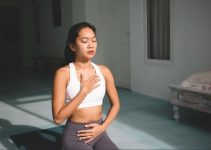
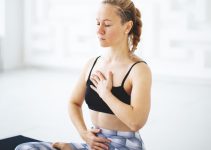


Bhastrika pranayam appears to me more confusing when I came to study from different experts and gurus. as you said and also Shivananda yoga says it is rapid inhale ( chest as well as abdomen) and exhale, but as per Ramdev baba, Yogacharya Manoj, Dhiraj, etc, it is only rapid or slows inhale and exhale of the chest. Which one is correct. also in bhasrika few seconds retention is advised or not. please clarify
Hello I have low blood pressure and when doing this for a few seconds I become light headed. Should I practice this ?
If it’s a consistent problem after each time you practice bhastrika pranayama, you should stop practicing it or if you still want to practice, do slower pace bhastrika (briefly mentioned in the article above).
The feeling of light-headedness comes when we breathe faster than our permissible limit so our heart becomes unable to pump enough blood to the brain. For a better experience, do a few rounds of Nadi Shodhana before Bhastrika.
Gd Mg. I am 70 years old. seek the following clarifications:
1. While doing pranayama, the stomach should come out for inhalation or be sucked in. That is, while exhaling, should the stomach be sucked in or pushed out. It is being taught both ways. Which is more scientific and healthy and helpful to the body?
2. Though I am 70 years, I am healthy. Have a slight Fasting Sugar [130] and BP for which I take tablets. I never felt any discomfiture during breathing exercises. But I recently came to know that strong breathing methods like Kabalapathi and Bhastrika could weaken/damage the lungs. Is it true? How to know that strong breathing practices are harmful and to be avoided by the elderly? Also is there any way to assess the strength of the lungs—it is said that the lungs could get cut off or damaged. Would be grateful to have your valuable advice.
Regards
Hello Sir, the natural movements of the stomach while breathing should be followed in the same way in pranayama. While inhalation, the diaphragm moves down, sucking air into the lungs so it pushes the abdominal contents down, which forces the stomach to come out. The reverse of it happens in exhalation (stomach go in).
Certainly, fast breathing exercises like kapalbhati and bhastrika should be avoided by elderly people but that doesn’t mean it weakens or damages the lungs. These breathing techniques were actually derived to strengthen the respiratory muscles but in elder people, ribcage capacity of expansion and contraction get reduced. Hence, it’s advised to not practicing fast breathing as it may overload ribcage capacity.
Elder people should practice slow, deep, and controlled breathing exercises. It removes ribcage stiffness and strengthens lung muscles. In pranayama, deep breathing exercises are anulom vilom pranayama, bhramari pranayama, and dirgha pranayama.
Thank you so much.
Very well explained. Thank You
So informative. I am 38 now and am healthy too. A small question to the author, whether these pranayamas will lead to health with perfection.
If you perform any of these pranayama with correct procedure & conditions, it will definetely lead to perfect health.